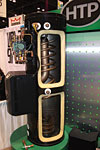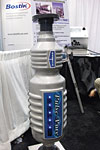
HTP’s Versa-Hydro combines space heating, domestic hot water and system control.
CHICAGO - All the green talk used to be about doing the right thing when it comes to the environment. It didn’t really seem to affect HVACR contractors in terms of the jobs they did or the bottom line.
But all that has changed. Now green has evolved into building sustainability, especially in regards to energy efficiency. And many of the upgrades that would please environmentalists are becoming more cost effective. Then, consider the fact that many such commercial building projects are requiring subcontractors, such as HVAC guys, to be certified through the environmentally focused Leadership in Energy and Efficiency Design (LEED) program.
All this adds up to reasons why the HVACR industry had better be watching what is happening as the world continues to go green.
Nowhere was this more evident than at last month’s Greenbuild International Conference & Expo in the newest - and most environmentally correct - section of the massive McCormick Place in Chicago.
There were some 1,000 exhibitors and more than 25,000 attendees. Many of the exhibitors are familiar names to HVACR contractors, and they showed some of their most energy-efficient and environmentally correct equipment. Then there were numerous companies showing ways to generate power to operate such equipment that extended well beyond the typical power grid and toward such approaches as wind and solar.
WHAT WAS THERE
Here, in alphabetical order, is a sampling of companies and technologies that HVACR contractors should be most aware of.Low-voltage ac drives fromABB (www.abb-drives.com) were featured at Greenbuild because of such features as interactive maintenance assistance that provides alerts when maintenance is needed, a fault logger to track down drive trips, two independent PID controllers, and the ability to pre-configure HVAC application macros, the company said.
High-efficiency design in boilers was shown byAerco (www.aerco.com). According to the company, “multiple thermal modules provide a level of built-in redundancy.”
Aquatherm(www.aquatherm pipe.com) showed polypropylene-random (PP-R), a highly engineered pressure pipe, that the company said has been approved by FM Global for use in concealed residential and light hazard fire sprinkler applications.
According to Barry Campbell, director of North American PR, “Our German-manufactured polypropylene piping products have been well established around the world for 35-plus years and are now making significant inroads into the North American HVAC, plumbing, and industrial piping markets. They offer a huge range of benefits such as leak and corrosion resistance, environmental friendliness, stable pricing, and heat fusion welding.”
A solar roof was shown byAtas(www.atas.com). The Ata-Solar has photovoltaics that are integrated into a standing seam metal roof.
A wind turbine shaped more like a flower than traditional wind vanes was shown byAVA(www.avapower.com). The turbine measured 4.5 feet high with a vertical design and was said to be for municipal, residential, and small commercial projects.

The
Pulse-Pure water treatment system from Evapco was created to provide scale,
microbiological and corrosion control.
The Tricoil fromBerner(www.berner.com) uses a hydronic recuperative loop process “designed to provide load-neutral conditions at a reduced tonnage, allowing for humidity control.”
Ice storage was featured byCalmac(www.calmac.com). It, according to the company, “mimics nature’s balancing of supply and demand, stores efficient nighttime energy as ice to augment the next day’s peak cooling, and helps earn credits for LEED certification.”
Carrier (www.carrier.com) launched its CO2NSERVATION meter, which calculates avoided greenhouse gas emissions as a result of the installation of high-efficiency Carrier air conditioning, heating, and refrigeration systems. “The meter is a powerful demonstration that technologies exist today to significantly reduce the energy consumption of HVACR systems,” said John Mandyck, vice president for sustainability and environmental strategies.
Cascade Engineering(www.swiftwindturbine.com) had information explaining the principle behind turbines, which it said “collects kinetic energy from the wind and converts it to useable electricity through an inverter.”
CertainTeed(www.certainteed.com) included solar technology for power generating in its showcase of products. This included EnerGen, a photovoltaic roofing system featuring integrated Uni-Solar® thin-film laminates. “Sustainability is not simply an item on CertainTeed’s mission and values checklist. It is integral and fundamental to our corporate values,” said Peter Dachowski, president and chief executive officer of CertainTeed. “Our proven leadership in innovation, sustainability, building science, and new technologies reaffirms our role in redefining the future of building design and construction.”
“A true heat recovery water-source heat pump system” was featured by CGC (www.cgc-group.com). It “combines water-source heat pumps and hydronic heating into one operating system,” the company said. “It can heat or cool any space at any time of the year. The hybrid system absorbs heat directly from the loop without additional heat generation since the compressors do not operate.”
ClimaCool(www.climacoolcorp.com) showed a simultaneous heating and cooling heat pump. Its SHC system “eliminates the need to have separate equipment for heating and cooling while saving installation costs, reducing the physical footprint and overall operating costs.” The setup “allows any module to be indexed for heating or cooling regardless of its position in the bank.”
The geothermal heat pump systems fromClimatemaster(www.climatemaster.com) included the Tranquility Medium Temperature Water to Water (TMW) units, capable of ground-loop (geothermal) as well as water-loop (boiler tower) applications.
Desert Aire (www.desert-aire.com) had dehumidifiers for confined area applications. Applications were listed in service sectors, water and wastewater industry, storage areas, and residential.
Desiccant Rotors International(www.driamerica.com) had a heat recovery wheel that the company said recovers sensible as well as latent heat.

A
low profile air curtain from Mars was promoted as a cost-effective
environmental and sanitation barrier.
Evapco (www.evapco.com) showed a Pulse-Pure water treatment system. The system uses pulsed power technology to provide chemical-free water treatment. It provides scale control, microbiological control, and corrosion control.
ECMs (electronically commutated motors) were featured byGenteq(www.thedealertoolbox.com). Specifications included constant speed, constant torque, brushless; ac single-phase input; and designs for direct-drive applications such as blowers and fan propellers.
Honeywell(www.windtronics.com) showed a wind turbine that it said always turns. The gearless blade power system was called “the future of wind power.” According to information at the booth, “The turbine utilizes a system of magnets and stators surrounding its outer ring capturing power at the blade tips where speed is greatest, practically eliminating mechanical resistance and drag.” The approach was described as applicable for homes and businesses.
HTP(www.htproducts.com) featured Versa-Hydro that combines space heating, domestic hot water, and system control in a compact, high-efficiency unit.
International Environmental Corp. (www.iec-okc.com) showed what was called Eco-telligent™ motors. The ECM motors are designed, said the company, to provide constant airflow by automatically adjusting fan power for a range of changing system static pressures to provide the desired air volume to the space.
“Green buildings that work” was the theme of the information supplied byJohnson Controls (www.makeyourbuildingswork.com).
The company drew attention to its part in retrofits at the Empire State Building, a Marine Corps air ground combat center, a bank plaza project that earned LEED gold certification, and its own headquarters, which earned LEED Gold.

As
part of McQuay’s presence at Greenbuild 2010 attention was paid to an energy
analyzer designed to estimate energy consumption or environmental impact of
equipment.
McQuay (www.mcquay.com) introduced the Daikin McQuay EnergyAnalyzer II, a software program - powered by the EnergyPlus™ simulation engine - used to provide a method of estimating energy consumption or environmental impact. The company said it can be applied to a variety of building types and HVAC systems to compare two design options simultaneously for performance, life-cycle cost, and environmental impact.
The software program includes an interactive user interface and predefined or customizable building templates to fit specific requirements. McQuay said it plans to make the new software tool available, for free, on the company’s website. “Daikin and McQuay are committed to sustainability and to providing industry-leading environmental technologies, so we wanted to provide a high-quality, nonbiased software program that’s easy for people to access and use and that’s also extremely accurate,” said Rick Hermans, director with McQuay’s Software Applications Group. “This software will not only help people do their job easier but also better.”
Munters(www.munters.us) noted it provides temporary dehumidification and ventilation at school construction sites.
The Virtual Moveable End Cap™ heat pump was featured by Multistack (www.multistack.com). The pump “offers efficiency in energy use, low costs to achieve redundancy, minimal refrigerant charges, and easy installation,” the company said. The approach uses multiple small compressors which can be cycled to match the building demand.
Among solar technologies was one called Photovoltaic Glass Unit (PVGU) fromPythagoras Solar (www.pythagoras-solar.com). It was promoted as a “transparent and high-density PVGU, which combines solar PV power generation with the modularity and insulating benefits of the standard insulating glass unit while preventing direct solar radiation from entering the building.”
Heat recovery ventilation systems fromProAir(www.proair-systems.com) recover heat energy in the exhaust air as it leaves a building and transfers it to the fresh air as it enters the building.
Among an extensive rollout of products and technologies fromRheem(www.rheem.com) were two solar water-heating solutions to the company’s line of SolPak® active solar water-heating systems: tankless gas products and Marathon™ storage tanks.
“Pairing SolPak with a Marathon storage tank or tankless gas product enables builders, architects, and designers to offer their customers exceptionally energy-efficient water-heating systems,” said Jeff Mahoney, Rheem alternative energy market manager.
“For the eco-conscious consumer, these products ensure 100 percent of hot-water needs in a way that significantly saves energy and money.” Since water heating can account for up to 20 percent of a home’s energy usage, solar energy is one of the most efficient ways to reduce environmental impact, save energy, and lower home utility costs, the company said.
Sanyo (www.sanyo.com/solar) promoted what is called “the most powerful solar panel on earth.” The HIT Double bifacial solar panel is “able to generate power from both sides simultaneously.”
SolarWall(www.solarwall.com) promoted a wall-mounted solar air-heating system to help offset the heating load in commercial and institutional buildings by preheating incoming ventilation air. It was noted that the approach allowed for anywhere from six to nine or more LEED points depending on the version of LEED.
SolarWorld(www.solarworldusa.com) had Sunmodules in a box channel frame design. Integrated bypass diodes and sealed welded connections are used. The molded fins on the exterior housing dissipate heat to maximize power output.
Windspire(www.windspireenergy.com) was designed, according to the company, to operate in areas with minimum average wind speeds of at least 10 mph. The turbine is 30 feet high and was said to generate electricity for immediate use in a home or business.
Publication date:12/27/2010


Report Abusive Comment